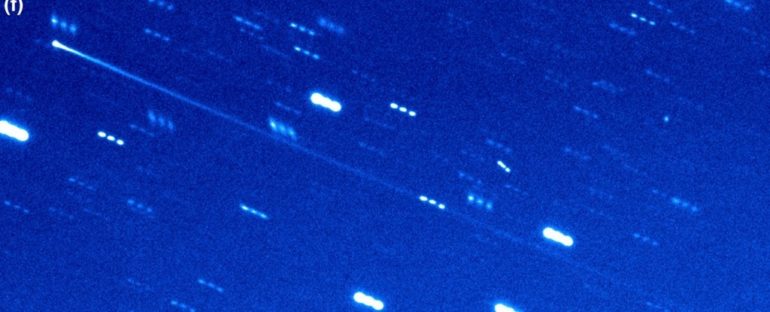Comets and asteroids are both types of rocks that hang out in space, but their differences are pretty pronounced.
Comets typically hail from the outer Solar System and have long, elliptical orbits. They’re filled with ices that start to sublimate when the comet gets close to the Sun, generating a dusty, misty atmosphere (called a coma) and the famous cometary tails.
Asteroids usually hang out in the main asteroid belt, between Mars and Jupiter, with orbits that are more like those of the planets. They’re also thought to be pretty dry and rocky, so they don’t tend to engage in the picturesque outgassing seen in their more exotic relatives.
A newly discovered space rock, however, seems to have characteristics of both. It’s called (248370) 2005 QN173, and it hangs out in the main asteroid belt, like millions of other asteroids, going around the Sun in a nice, planet-style almost-circle.
But, like a comet, in July of this year, 248370 was spotted showing signs of outgassing at its closest approach to the Sun (perihelion), and a long, cometary tail. This would make it a rare hybrid of the two – a type of object we call an active asteroid, or main-belt comet.
It’s one of just 20 or so of these rarely seen objects – among the over 500,000 known main-belt objects – that have been suspected of being main-belt comets, and just the eighth object of this type confirmed. Moreover, astronomers have discovered that the object has been active more than once.
“This behavior strongly indicates that its activity is due to the sublimation of icy material,” said astronomer Henry Hsieh of the Planetary Science Institute.
“248370 can be thought of as both an asteroid and a comet, or more specifically, a main-belt asteroid that has just recently been recognized to also be a comet. It fits the physical definitions of a comet, in that it is likely icy and is ejecting dust into space, even though it also has the orbit of an asteroid.
“This duality and blurring of the boundary between what were previously thought to be two completely separate types of objects – asteroids and comets – is a key part of what makes these objects so interesting.”
The behavior of 248370 was discovered on 7 July 2021, in data from the robotic astronomical survey Asteroid Terrestrial-Impact Last Alert System (ATLAS). Confirmation observations taken by Lowell Discovery Telescope showed clear signs of a tail, and a perusal of the data from the Zwicky Transient Facility showed the tail appeared as early as 11 June.
Between 8 July and 14 August, new follow-up observations were taken using different telescopes, confirming earlier data. There, in the asteroid belt, 248370 was sporting an absolutely stylin’ tail.
Measurements taken by Hsieh and his team revealed that the cometary nucleus – that’s the chunk of rock from which the tail extends – is around 3.2 kilometers (2 miles) across. In July, the tail was more than 720,000 kilometers (450,000 miles) long, but just 1,400 kilometers (900 miles) wide. That’s crazy narrow in comparison to the tail’s length.
“This extremely narrow tail tells us that dust particles are barely floating off of the nucleus at extremely slow speeds and that the flow of gas escaping from the comet that normally lifts dust off into space from a comet is extremely weak,” Hsieh explained.
“Such slow speeds would normally make it difficult for dust to escape from the gravity of the nucleus itself, so this suggests that something else might be helping the dust to escape.
“For example, the nucleus might be spinning fast enough that it’s helping to fling dust off into space that has been partially lifted by escaping gas. Further observations will be needed to confirm the rotation speed of the nucleus, though.”
Further observations will help us better understand the object, too. Based on our understanding of the Solar System, 248370 and the other main-belt comets shouldn’t exist. That’s because the main asteroid belt is thought to have been there since the formation of the Solar System, around 4.6 billion years ago.
The asteroid belt lies between around 2.2 and 3.2 astronomical units from the Sun. The Solar System’s frost line – the point beyond which it is cold enough for ice to form in a vacuum – is at around 5 astronomical units. So it’s unclear why these main-belt comets have retained enough ice to produce cometary sublimation activity.
In addition, they could help us understand a little bit about Earth, too. In the early days of the Solar System, impacts from asteroids bearing water could have been one of the ways water was delivered to Earth. If main-belt comets have water, we might be able to explore this idea a little further.
“In the long term, 248370 will be well-placed for monitoring during the approach to its next perihelion passage on UT 2026 September 3,” the researchers write in their paper.
“Monitoring during this time will be extremely valuable for further confirming the recurrent nature of 248370’s activity, constraining the orbital range over which activity occurs (with implications for constraining ice depth on the object, as well as its active lifetime), measuring initial dust production rates, and comparing the object’s activity levels from one orbit to another as well as to other main-belt comets.”
The research was presented at the 53rd Annual Meeting of the AAS Division for Planetary Sciences, and has been accepted into The Astrophysical Journal Letters. It’s currently available on preprint site arXiv.



